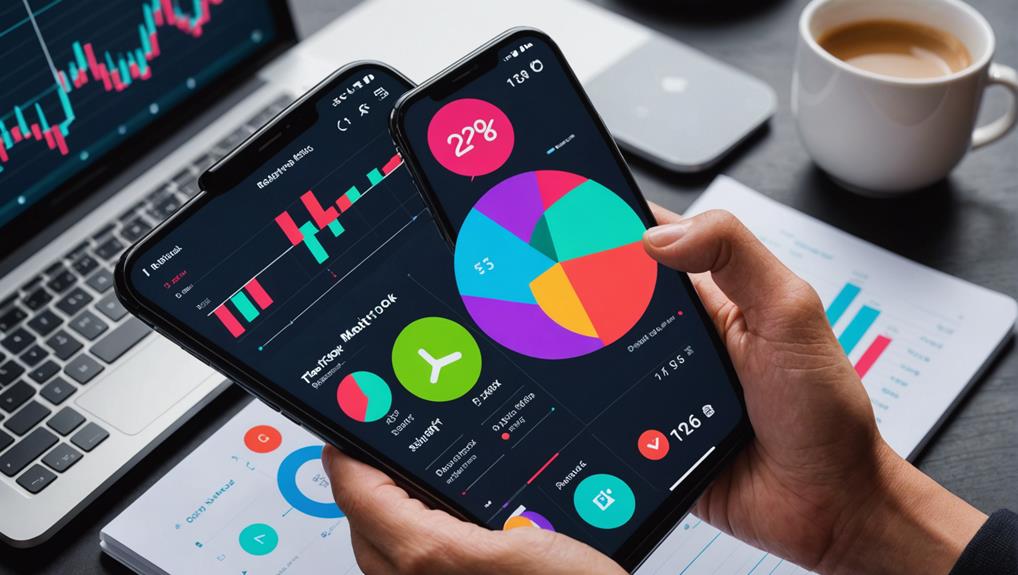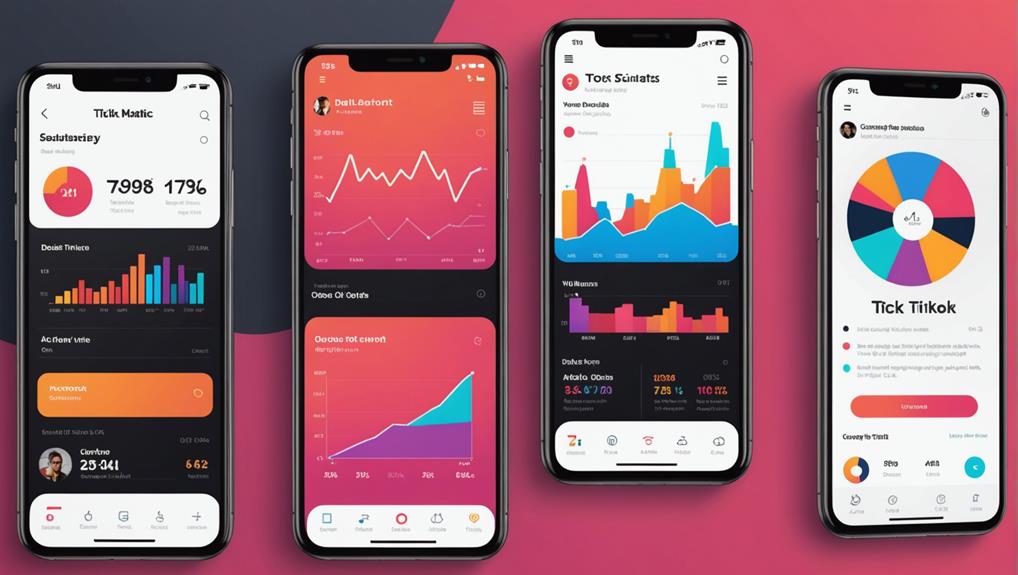TikTok user behavior trends are shifting due to several interrelated factors. Demographic shifts show that 58% of users are now above 25, requiring brands to adjust their strategies to appeal to older audiences. Algorithmic enhancements optimize personalized content delivery, increasing user engagement to an average of 95 minutes per day. Evolving content formats, such as longer video options, cater to a demand for immersive storytelling. Additionally, increased user focus on cultural and ethical content, such as inclusivity and sustainability, reshapes user interactions. As these dynamics continue to develop, further changes in user behavior could be anticipated.
Key Takeaways
- Demographic shifts, with more users over 25, influence content preferences and engagement strategies on TikTok.
- Enhanced algorithms deliver personalized content, boosting user engagement and altering behavior patterns.
- A rise in longer video formats caters to demand for immersive storytelling, affecting user consumption habits.
- Cultural and ethical influences, like inclusivity and sustainability, shape user expectations and engagement.
- TikTok’s growing role as a search engine shifts user behavior towards information gathering on the platform.
Demographic Changes
As TikTok continues to evolve, a significant demographic shift has emerged, with over 58% of its users now above the age of 25. This development marks a pivotal change in the platform’s user composition, challenging its image as a Gen Z-dominated space. The influx of older users has diversified content interests, prompting a broader spectrum of videos that cater to varied tastes.
This shift underscores the importance of understanding demographic trends in shaping content creation strategies on TikTok. Brands and marketers must now recalibrate their approaches, considering the diverse age groups actively engaging on the platform.
The new demographic landscape necessitates a dual-focus in marketing strategies, where content must appeal to both younger and older audiences. This requires a nuanced understanding of preferences and behaviors across age segments, ensuring that marketing messages resonate effectively.
The evolving user base highlights an imperative for brands to innovate and adapt, integrating insights from demographic trends into their campaigns. As TikTok’s audience continues to mature, the platform offers a unique opportunity for marketers to connect with a wider range of consumers, ultimately optimizing community engagement and driving more meaningful interactions.
Algorithmic Enhancements
TikTok’s algorithmic advancements greatly enhance user engagement by leveraging personalized content recommendations based on intricate analysis of user interactions, such as likes, shares, and comments.
This data-driven approach guarantees that content with high engagement metrics gains increased visibility, providing creators with opportunities to reach wider audiences.
As a result, the platform not only delivers a tailored user experience but also adapts to evolving trends, which supports a diverse range of content interests and engages a broader demographic.
Personalized Content Recommendations
Personalization stands at the forefront of TikTok’s algorithmic advancements, transforming user engagement through meticulously tailored content recommendations. As TikTok trends evolve, the platform’s algorithm fine-tunes its understanding of user-generated content, ensuring an engaging and personalized experience. By analyzing user interactions such as likes, shares, and comments, TikTok crafts a feed that resonates uniquely with each user, driving engagement and satisfaction.
The algorithm’s commitment to showcasing fresh, unique content maintains the platform’s dynamic nature, where users are continuously exposed to new trends and creators. This strategy not only sustains user interest but also enhances the discovery aspect of TikTok, with 41% of users leveraging the platform as a search engine. The relevance of personalized content recommendations is further amplified through the strategic use of video information, including captions and hashtags, which aligns content with user preferences.
| Key Metrics | Impact on Personalization |
|---|---|
| User Interactions | Enhances engagement and feed |
| Fresh Content Focus | Drives discovery and trends |
| Video Information | Aligns content with interests |
Advanced targeting and retargeting capabilities underscore TikTok’s predictive prowess, resulting in longer user engagement times, averaging 95 minutes per day. This algorithmic precision highlights TikTok’s role in redefining content personalization.
Engagement Metrics Influence Visibility
With personalized content recommendations as a cornerstone of TikTok’s algorithm, the role of engagement metrics in influencing visibility becomes increasingly significant. TikTok’s algorithm leverages user interactions—such as likes, shares, and comments—to personalize content feeds, thereby enhancing a creator’s visibility when their content achieves high engagement metrics. This data-driven approach guarantees that videos resonating with audiences gain traction, reinforcing the platform’s dynamic nature.
Continuous updates to TikTok’s algorithm maintain its vibrancy, promoting content that is both fresh and relevant. These enhancements prioritize unique and engaging content, rewarding creators who consistently deliver material that captivates their audience. As a result, creators who successfully tap into audience preferences see increased content visibility, which in turn drives further engagement.
Engagement metrics consequently serve as a critical component in TikTok’s content recommendation process. By tailoring feeds to individual user preferences, TikTok not only enhances user satisfaction but also fosters deeper interaction with the platform.
This tailored approach not only benefits users by presenting them with content they are likely to enjoy but also incentivizes creators to produce high-quality, engaging content. Consequently, the symbiotic relationship between engagement metrics and visibility continues to shape user behavior trends on TikTok.
Content Format Evolution
The evolution of content formats on TikTok is characterized by a strategic shift towards longer video formats and an expansion of interactive features, reflecting a deliberate response to user demand for more immersive storytelling experiences.
Data indicates that these longer formats enable creators to foster deeper user engagement and interaction, while the integration of polls and Q&A sessions serves as a catalyst for attracting diverse audiences.
This trend underscores a broader shift in user preferences, emphasizing authenticity and narrative depth, which is essential for sustaining user interest and maintaining competitive edge in the dynamic social media landscape.
Transition to Longer Videos
In the evolving landscape of social media, TikTok is experiencing a significant shift as it embraces longer video formats, marking a pivotal change in content creation and consumption.
This alteration is redefining how TikTok content is produced and received, with both creators and users being encouraged to engage in more substantial storytelling. TikTok’s algorithm now supports this shift by prioritizing engagement metrics that favor longer videos, particularly when they resonate effectively with viewers.
This evolution is not just a trend; it’s a strategic adaptation that aligns with changing user preferences.
- Broader Audience Appeal: Longer videos are attracting users over 25, who prefer in-depth, narrative-driven content.
- Content Richness: Creators are enabled to deliver more extensive stories, enhancing content quality and depth.
- User Engagement: Enhanced interaction in longer videos supports creator growth and diverse content creation.
- Algorithm Support: TikTok’s algorithm favors longer videos that show strong engagement, driving their visibility.
- Brand Opportunities: Brands can utilize longer formats to build informative, engaging narratives, boosting audience loyalty.
As users adapt to this new content landscape, this shift presents valuable opportunities for creators and brands to connect with and captivate their audiences more deeply.
Interactive Features Expansion
As TikTok continues to refine its platform, interactive features are becoming a cornerstone of its content format evolution, offering creators powerful tools to foster deeper user engagement. This strategic pivot from short to longer video content allows for more thorough storytelling, thereby enriching user interaction and enhancing content depth.
The integration of features such as polls, Q&A sessions, and duets is essential, as these elements facilitate dynamic engagement by encouraging users to participate actively in content creation.
The emphasis on user-generated content, particularly through trending challenges, serves to greatly boost brand visibility and community involvement. Trends like these are not merely about entertainment; they are instrumental in cultivating a participatory culture where users feel invested in the content.
This participatory approach is vital in attracting and retaining diverse audiences, as the demand for engaging and immersive experiences continues to rise.
Moreover, the utilization of interactive features enables creators to forge stronger connections with their audience. This connection translates into increased viewer loyalty and enhanced engagement metrics, underscoring the importance of these features in TikTok’s growth strategy.
As creators tap into these tools, they not only diversify their content but also deepen the platform’s community ties.
Cultural and Ethical Influences
Evolving cultural dynamics on TikTok have considerably influenced user behavior, as evidenced by a marked increase in engagement with content that prioritizes inclusivity and diversity. This shift reflects the broader societal values that are reshaping consumer behavior towards more ethical engagement.
Users now gravitate towards content that challenges traditional norms, such as body positivity movements that disrupt conventional beauty standards. This trend signifies a growing preference for ethical content creation, which resonates deeply with the platform’s audience.
Brands and content creators are increasingly responding to these shifts by integrating themes of sustainability and social justice into their narratives. The demand for authenticity is compelling businesses to align their strategies with these cultural dynamics, ensuring that their messaging is not only relevant but also ethically sound.
This change is evident in the rise of user-generated content initiatives that emphasize communal participation and social advocacy.
- Inclusivity and Diversity: Content that embraces varied cultural backgrounds and identities.
- Body Positivity: Challenging and redefining beauty norms.
- Sustainability: Promoting environmentally friendly practices.
- Social Justice: Addressing societal inequalities through creative expression.
- Authentic Storytelling: Building trust through genuine and ethical narratives.
Emotional and Authentic Engagement
Emotional storytelling serves as a cornerstone for authentic engagement on TikTok, playing a pivotal role in cultivating profound connections between users and content. By evoking emotions, creators can foster deeper engagement and loyalty, as users are drawn to narratives that resonate on a personal level.
Data indicates that 88% of TikTok users perceive content on the platform as unique, underscoring the vital role of authenticity in driving user engagement. This uniqueness often stems from creators sharing genuine experiences, which not only enhances emotional connectivity but also distinguishes TikTok from other social media platforms.
Moreover, behind-the-scenes content greatly boosts transparency, allowing users to perceive brands and creators as sincere. This transparency is a key factor in building customer loyalty and trust, as authentic narratives resonate more effectively with audiences.
Such resonance is essential as it leads to higher sharing rates, amplifying the reach and impact of the content. Additionally, the rise of themes like body positivity and sustainability reflects broader cultural dynamics, with users increasingly drawn to content that embodies inclusivity and ethical consciousness.
These trends highlight the importance of emotional storytelling and authenticity in shaping user engagement on TikTok.
Impact of Viral Sounds
The landscape of TikTok user engagement is not only shaped by the authenticity of emotional storytelling but also greatly influenced by the strategic use of viral sounds. Viral sounds have emerged as a cornerstone in TikTok marketing, transforming ordinary songs into sensational trends that drive user interaction. This auditory phenomenon is not just about catchy tunes; it’s a potent tool for enhancing user engagement across diverse content.
Incorporating viral sounds into marketing strategies allows brands to resonate deeply with audiences, creating a robust emotional connection. This connection is essential, as it can amplify the reach and effectiveness of marketing campaigns. Current popular viral sounds such as “did i tell u that i miss u” and “Katana” exemplify the potential for brands to gain visibility and foster engagement.
Consider the following impacts of viral sounds:
- Enhanced Emotional Connection: Sounds evoke emotions, forging a deeper connection with audiences.
- Increased Visibility: Catchy sounds can propel content to viral status.
- Improved Brand Resonance: Aligning with trends enhances brand relatability.
- Effective Storytelling: Sound-visual pairing enhances narrative impact.
- Consumer Engagement: Creates enjoyable and immersive shopping experiences.
Ultimately, TikTok’s emphasis on sound-visual storytelling makes viral sounds a powerful element in engaging users effectively.
TikTok as a Search Engine
A significant proportion of TikTok users, approximately 41%, are now utilizing the platform as a search engine, reflecting a dynamic shift in digital information-seeking behaviors. This phenomenon highlights TikTok’s evolving role beyond entertainment, positioning it as the fourth most helpful information source globally.
Remarkably, 10% of Gen Z users prefer TikTok over traditional search engines like Google, indicating a generational shift towards visual and concise content for acquiring knowledge. This trend underscores the platform’s appeal to younger demographics who favor quick, engaging video formats over text-heavy alternatives.
TikTok as a Search is particularly prominent in lifestyle and consumer content, encompassing interests such as food, music, DIY, and fashion. This aligns with the shopping habits of Gen Z, who are increasingly seeking recommendations and reviews in an interactive format.
The platform’s algorithm, which tailors content based on user preferences, further enhances its search capabilities, making it a potent tool for discovering trends and products. Additionally, TikTok’s rapid ascent as a news source in regions like the UK emphasizes its capacity to deliver timely information, reinforcing its role in shaping modern information consumption patterns.
Future User Behavior Trends
As TikTok continues to evolve, user behavior trends are projected to undergo significant changes, driven by a demographic shift and the platform’s adaptive algorithm. With over 58% of users now above 25 years old, content on TikTok is diversifying, reflecting broader interests and more sophisticated narratives.
TikTok’s algorithm, which personalizes content based on user interactions, is essential in maintaining engagement and encouraging tailored content consumption, making it a powerful tool in social media marketing strategies.
The following trends are anticipated to shape future user behaviors on TikTok:
- Longer Content Formats: Shift to longer videos allows for deeper storytelling and more complex narratives.
- Inclusivity and Diversity: Content focusing on cultural dynamics, sustainability, and social justice is gaining traction.
- Search Functionality: With 41% of users using TikTok as a search engine, the platform’s role in information gathering and purchasing decisions is expanding.
- Demographic Shift Influence: Older users bring diverse content interests, influencing a broader range of topics.
- Enhanced Engagement: The personalized algorithm continues to drive user engagement by offering relevant content.
These trends underscore TikTok’s evolving landscape, emphasizing its growing influence in digital marketing and social media dynamics.
Frequently Asked Questions
How Has Tiktok Changed Consumer Behavior?
TikTok has altered consumer behavior by transforming into a key platform for product discovery through TikTok shopping, driving user engagement via viral challenges, and shifting search preferences, consequently influencing purchasing decisions and enhancing brand interaction.
How Does Tiktok Influence People’s Behavior?
TikTok influences behavior by promoting content creation, where users seek social validation through likes and shares. This drives trend adoption, as the platform’s algorithm highlights popular content, encouraging users to emulate trends and engage with prevailing cultural narratives.
Why Are Tiktok Trends Popular?
TikTok trends gain popularity through trend evolution driven by content virality and heightened audience engagement. The platform’s algorithmic precision, diverse content formats, and community-centric features amplify user interaction, resulting in rapidly shifting, widely shared, and culturally resonant trends.
Conclusion
The shifting user behavior trends on TikTok can be attributed to a confluence of demographic changes, algorithmic advancements, and evolving content formats. Cultural and ethical considerations, alongside a preference for emotional and authentic engagement, further influence these behaviors. Additionally, the impact of viral sounds and TikTok’s emerging role as a search engine contribute to this dynamic landscape. Future trends will likely continue to be shaped by these factors, alongside technological innovations and changing user expectations, necessitating ongoing analysis.




